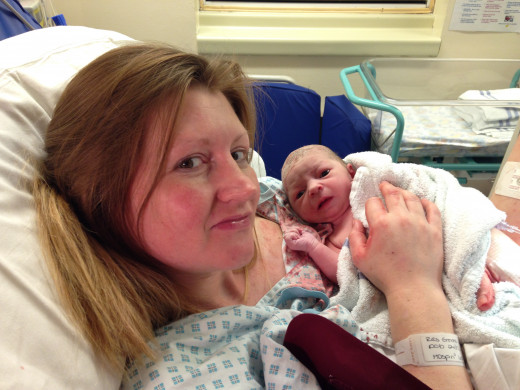- HubPages»
- Health»
- Women's Health»
- Pregnancy
Ways to Relieve Pain when Giving Birth

Preparing for Labour
A normal healthy pregnancy lasts for 40 weeks and is split into three trimesters. The first trimester for the first three months (up to week 12) is when hormones kick in. Your body has to accept the fact that there is a growing fetus in your uterus and it needs to adapt.
Because of the changes your body makes, you may feel nauseous or have morning sickness and be quite sensitive to tastes and smells. The two hormones oestrogen and progesterone are thought to be the cause, although experts still do not know for sure.
You may also have tender breasts, feel tired, and cartilage softens to prepare the body for childbirth, causing back and hip pain.
The second trimester welcomes increased energy levels as hormones stabilize. Morning sickness tends to subside by this stage of pregnancy and this trimester is said to be the most enjoyable time.
By the third trimester the baby is getting larger, moving down towards the pelvic area. Pressure on the bladder creates the need to urinate more often and the body is almost prepared for the big day.

Thinking about Pain Relief
Most pregnant women will think about the day they will give birth and what to expect. Even for those who are not first time Mothers, the labour cannot be predicted as each birth is different.
Some labours are quick, some are a lot slower and some have complications. It is better to therefore consider a second or third option for pain control, in case things don’t go to plan.
What are the Options?
If you are planning on having a home birth as opposed to a hospital one your choices of pain relief can be limited. You may be able to have gas and air, but not an epidural.

Entonox (Gas and Air)
This is otherwise known as laughing gas and is commonly used to help with pain.
Entonox is a gas made up of nitrous oxide and oxygen and can be supplied in portable gas cylinders for those who are in labour away from a hospital or birth centre.
By breathing in some of the gas during a contraction through a mouthpiece, you will feel a relaxing sensation. This is to take the edge of the contraction and help you to cope with it.
Pros of Gas and Air
Gas and Air can be portable or supplied readily in hospital. This means it will always be to hand whenever a strong contraction comes on.
It is safe to use when used correctly and can even be used in a birthing pool. There are no after effects and you take as much or as little as you wish.
You can use other forms of pain relief in conjunction with gas and air.
Cons of Gas and Air
It can take a while to get the hang of taking entonox and breathing it in at the same time as your contraction.
Some women feel that the pain relief isn't enough, especially in the final part of labour.
Entonox can carry side effects, such as feeling dizzy or nauseous. It can also give you a dry mouth so use lip balm and take sips of water.
Pethidine
Pethidine is a pain killing drug injected by the midwife to help with the pain in the early stages of labour. It is a stronger pain reliever to entonox, but can be used together with it.
It is usually given with an anti-sickness drug as it can make you feel nauseous.
Pethidine is a synthetic version to morphine and helps you to relax during childbirth as well as ease the pain.
It cannot be given in the later stages of labour (when the cervix is fully dilated at 10cm) as it can affect the baby, but given early on means you can get some rest in an uncomfortable labour.
Pros of Pethidine
Pethidine may be more effective with pain than gas and air.
It can be given by the midwife so you don’t have to wait for an anaesthetist or a doctor.
In some cases it can be used at home or in a birthing pool.
It won’t slow down labour.
It is relaxing and can help with anxiety.
Cons of Pethidine
Pethedine tends to last between 2 to 4 hours, so if the labour is longer it can wear off.
It can make you feel drowsy and wanting to sleep rather than push.
There is a possibility it can affect the baby and make him drowsy, making breast feeding difficult.
It can make you feel dizzy or sick.
Tens
A tens machine is a portable device and a good way of coping with contractions at home. Tens stands for transcutaneous electrical nerve stimulation and it is worn on the body. Small sticky pads attach to your lower back with wires sending electrical pulses to block pain between the spinal cord and brain.
You can hire one out or purchase a tens machine and use it whenever you need it. They can be used for back pain as well as labour pain.
There are normally two settings on a tens machine. The lower setting sends out pain relieving endorphins to help with mild pain, while the high setting is meant to block out pain completely.
Pros of Tens Machine
Having one at home can help you wait longer before going into hospital, or is good for a home birth.
The controller is small so you can move around without restriction.
You can boost the setting when the contraction is strong.
It is drug free and won’t interfere with you or your baby.
You have full control over it.
Cons of a Tens Machine
The pain relief is quite mild and won’t help in the later stages of labour
You cannot use it in a birthing pool.
It may take up to an hour to become effective.
You will have to remove it if you need your back massaged.
Epidural
Epidural anaesthesia is an injection in the lower back to eliminate pain.
They are carried out by qualified anaesthetists, where the needle is placed in the epidural space of the spine. If placed correctly the drug helps to numb areas below the waist so that labour pains cannot be felt.
When the epidural is being administered, a fine catheter tube is left in the space and taped up. This is so the pain reliever can be topped up if it begins to wear off.
The pain signals are cut off to the brain but feelings in your tummy area and legs are lost. This means you will be confined to the bed unless a lower dose is administered (mobile epidural).
Pros of Epidurals
If effective, all labour pains are relieved meaning you can get some rest.
The midwife can administer top ups, so you don’t have to wait for the anaesthetist.
If you need an emergency cesarean, you only need to be topped up with a local anaesthetic.
It can lower high blood pressure.
You will have a clear mind.
You do not need painkillers after childbirth if you need stitches.
Cons of Epidurals
They do not always work if they are not placed correctly.
There may be a risk of infection.
They can cause back pain afterwards.
You won’t be able to move around, so you will feel numb and uncomfortable.
Your blood pressure and your baby will be monitored constantly.
You may not be able to get up and walk straight away after the baby is born.
You lose sensation to pass urine, so a catheter tube will need to be inserted.
You will not feel the urge to push, so this needs to be encouraged.
The baby may not move into a good position so ventouse or forceps may need to be used.
Hydrotherapy
Hydrotherapy is when water is used during labour. A special birthing pool can be used with warm water (which does not exceed 37 degrees) to relax during contractions.
Some women also give birth in the pool as they feel it is natural for them and their baby.
If you don’t wish to use a birthing pool, a warm bath can also help. If you are in hospital you can ask to use one.
Pros of a Water Birth
The water supports your body and can increase the speed of labour.
You may be less likely to need drugs (especially in the first stages of labour), such as pethidine.
The water is relaxing and good for anxiety and pain.
You can move around easily in the water to change position.
Cons of a Water Birth
The water should not exceed 37 degrees or the baby may find it hard to control its temperature.
There is also a risk of labour slowing down as the water relaxes the muscles.
The hospital or birthing centre may not provide birthing pools.
They can get messy.
You cannot have a water birth if you've had a complicated pregnancy, or are having twins or more.
Massage
There are alternative forms of pain relief when you are due to give birth if you want to do it naturally.
Massage is one way to ease pain, relax tension and be close to your birthing partner.
By getting your partner to massage your back, lower back and sacrum area will act as a form of pain control. The nerve fibres divert from the labour pain when stimulated and endorphins are released.
Your partner’s touch will reduce anxiety as they rub your back, buttocks, tops of your thighs , hands, feet and shoulders. Discuss beforehand how you like to be massaged and see if classes are available to learn how to do it.
Essential oils can add to a relaxing atmosphere but be sure to check which ones are safe and use carrier oil.
Pros of Massage
It is natural.
It is beneficial in the first stages of labour.
It can bring you close to your partner.
It releases mood lifting endorphins.
It is relaxing.
Cons of Massage
You partner may need a break.
You may not like it in the later stages of labour.
You may need extra pain relief in the later stages.
You may do a birthing plan towards the time of having your baby, but the plan may not always run smoothly. Keep an open mind over what kind of pain relief you may want and consider alternatives if what you want isn't available.
Poll
What sort of pain relief would you choose in labour?
Prevent nausea during pregnancy
- How To Prevent Nausea During Pregnancy
Being pregnant should be an exciting time for Mothers to be, but suffering from nausea can make life miserable. Morning sickness during pregnancy is common but can make day to day living hard. There are many ways to alleviate the problem and here are
How to have a baby on a budget
- Parenting advice: Having a baby on a budget
Whether you've planned to start a family or if it's a surprise, there's no escaping the fact that babies are expensive. This begins from pregnancy through to when they are 'big' kids. If you are on a budget you need to know how to save and how to ens







